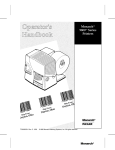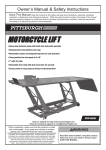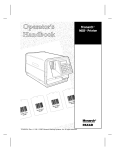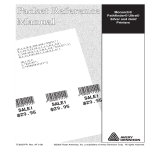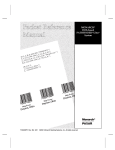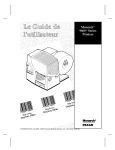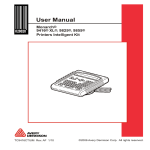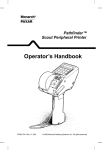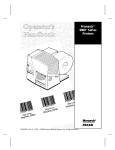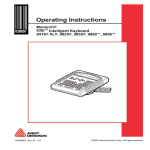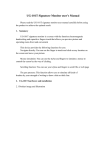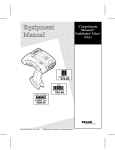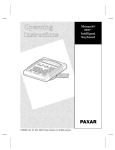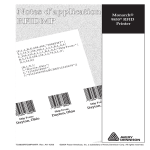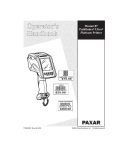Download Monarch 9800™ Series Printers
Transcript
Monarch 9800 Series Printers TC9830OH Rev. B 1/98 ©1996 Monarch Marking Systems, Inc. All rights reserved. Each product and program carries a respective written warranty, the only warranty on which the customer can rely. Monarch reserves the right to make changes in the product, the programs, and their availability at any time and without notice. Although Monarch has made every effort to provide complete and accurate information in this manual, Monarch shall not be liable for any omissions or inaccuracies. Any update will be incorporated in a later edition of this manual. ©1996 Monarch Marking Systems, Inc. All rights reserved. No part of this publication may be reproduced, transmitted, stored in a retrieval system, or translated into any language in any form by any means, without the prior written permission of Monarch Marking Systems, Inc. WARNING This equipment has been tested and found to comply with the limits for a Class A digital device, pursuant to Part 15 of the FCC Rules. These limits are designed to provide reasonable protection against harmful interference when the equipment is operated in a commercial environment. This equipment generates, uses, and can radiate radio frequency energy and, if not installed and used in accordance with the instruction manual, may cause harmful interference to radio communications. Operation of this equipment in a residential area is likely to cause harmful interference in which case the user will be required to correct the interference at his own expense. CANADIAN D.O.C. WARNING This digital apparatus does not exceed the Class A limits for radio noise emissions from digital apparatus set out in the Radio Interference Regulations of the Canadian Department of Communications. Le présent appareil numérique n’émet pas de bruits radioélectriques dépassant les limites applicables aux appareils numériques de la classe A prescrites dans le Réglement sur le brouillage radioélectrique édicte par le ministère des Communications du Canada. Trademarks MONARCH is a registered trademark of Monarch Marking Systems, Inc. 9800, 9820, 9830, and 9835 are trademarks of Monarch Marking Systems, Inc. Microsoft and MS-DOS are registered trademarks of Microsoft Corporation. Windows is a registered trademark of Microsoft in the U.S. and other countries. Centronics is a registered trademark of Centronics Data Computer Corporation. TrueType is a trademark of Apple Computer, Inc. Hewlett-Packard is a registered trademark of Hewlett-Packard Company. Adobe and Acrobat are trademarks of Adobe Systems Incorporated which may be registered in certain jurisdictions. Monarch Marking Systems P.O. Box 608 Dayton, Ohio 45401 Technical Support in Switzerland: Gomaro s.a. - 1123 Aclens http://www.gomaro.ch e-mail: [email protected] Tel.: 021 869 97 70 STATEMENT OF WARRANTY ON MONARCH MACHINES Limited Warranty THIS LIMITED WARRANTY IS IN LIEU OF AND EXCLUDES ALL OTHER WARRANTIES OR REPRESENTATIONS EXPRESSED OR IMPLIED, INCLUDING MERCHANTABILITY OR FITNESS FOR BUYER’S PURPOSES. THERE IS NO WARRANTY WHICH EXTENDS BEYOND THE LIMITED WARRANTY. The Monarch product covered by this limited warranty is warranted to be free from defects in materials and workmanship for a period of one (1) year from the date of shipment to the original purchaser. The limited warranty on the printhead is one (1) million inches or 100,000 inches for High Energy Ribbon. This limited warranty does not cover damage by accident, abuse or violence, or use by the original purchaser of other than the standard supplies furnished by or meeting the specification of Monarch, or the Monarch product is operated or maintained contrary to the instructions provided by Monarch. This warranty is void if the machine is altered or repaired by other than Monarch representatives. This warranty does not include the furnishing of ribbons, ink rollers, tags, labels, or other supplies. The Monarch product requiring warranty service may be shipped to the nearest authorized Monarch service facility with the transportation charges PREPAID. Monarch is NOT responsible for damage that occurs during shipment if the product is not shipped in the original Monarch packaging. The Monarch product will be repaired free of charge during the warranty period. This warranty is valid only in the United States. 1 G E T T I N G S TA R T E D The Monarch ® 9820 printer and Monarch ® 9830 printer let you print text, graphics, and bar codes on thermal transfer (ribbon) and thermal direct labels. The 9820 printer prints labels continuously (in one strip) or on-demand (one label at a time). The 9830 printer has a peel bar that allows labels to be peeled as they are printed in the on-demand mode. You can print on die cut, black mark, or non-indexed (continuous) supplies. Non-indexed supply does not have perforations or black marks and must be used in continuous mode. See Appendix B, "Setting DIP Switches," to select your supply type. This chapter includes information about u unpacking the printer. u connecting the power cord. u connecting the communications cable. u using the printer’s control panel. Getting Started 1-1 Audience The Operator’s Handbook is for the person who prints and applies labels. Ordering Programmer’s Manuals An online version of the Packet Reference Manual describes how to create a format and batch packets for printing labels, how to configure the printer online, how to diagnose printer error messages, and how to perform other advanced techniques. It is included with the MONARCH ® quick-set software where you can print this manual or order a hard-copy version of the Packet Reference Manual (part number TC9800PM). To install the software, see Chapter 2, "Using the Software." Unpacking the Printer After you unpack the printer, you should have: u 9820 or 9830 printer u Power cord u Ribbon take-up core (may already be on take-up reel) u Operator’s Handbook u MONARCH quick-set software. Keep the box and packaging material in case the printer ever needs repair. 1-2 Getting Started Connecting the Power Cable To connect the power cable: 1. Plug the power cable into the socket. Plug the other end of the cable into a grounded electrical outlet. Power Cable goes here 2. Turn on the printer. Press ( I ) to turn on and ( O ) to turn off the printer. For information about replacing the fuse, see Chapter 6, "Care and Maintenance." Establishing Communications Before the printer can accept print jobs from the host, you must: u Connect the communication cable to the printer and to the host. u Set the communication values on the printer to match those at the host. (Only required if you are using the serial port.) Getting Started 1-3 Connecting the Communication Cable Make sure the printer is off before connecting the cable to the communication port. Ask your System Administrator which method you will use to communicate with the host: u Serial Communication 9 to 25 pin cable (Part #118364) 25 to 25 pin cable (Part #118366) u Parallel Communication IEEE-1284 or Centronics® mode cable (Part #118363) See Appendix B, "Setting DIP Switches" for more information. 1-4 Getting Started Connect the communication cable into the appropriate port. Secure the cable with the connecting screws (serial) or spring clips (parallel). Parallel Port Serial Port Default Serial Port Communication Values If you are communicating with the host through the serial port, make sure the printer’s communication values match those at the host. The factory default values are: u Baud: 9600 u Word Length: 8 bit data frame u Stop Bits: 1 stop bit u Parity: none u Flow Control: DTR To change the printer’s communication values, ask your System Administrator or see Appendix B, "Setting DIP Switches." Getting Started 1-5 Using the Control Panel The control panel helps you check printer status, displays error codes, and allows you to perform some basic printer functions. Printer Status Lights Power: The printer shows a steady green light when it is on. Supplies: The printer shows a blinking amber light when it is out of labels or ribbon, or when you have a supply jam. Paused: The printer shows a steady amber light when paused. The printer shows a blinking amber light when there is a data, communication, or data formatting error. See the status code box for the error code. The printer also shows a blinking amber light when it’s ready to print a label in the on-demand mode. See "On-Demand Mode Printing" for more information. 1-6 Getting Started Button Functions Feed: u Prints a label in the on-demand mode. u Feeds a blank label if there is no print job. u Prints a label with error information that is useful to your System Administrator. Pause: Pauses the current print job or resumes a paused print job. Feed and Pause: Prints a test label when you press the buttons at the same time. Feed and Clear: Allows you to adjust print positions from paused mode. See "Adjusting Print Positions" in Chapter 5 for more information. Clear: u Clears an error. u Cancels the current print job. u Cancels all queued print jobs if pressed for two seconds. Also clears the communication queue and cancels any packet being received. To cancel a single or all queued print jobs, the printer must be in paused mode before Clear is pressed. Status Code Box The status code box displays a three-digit error code to identify any problem the printer may have. For a description of the problem, look up the error code in Chapter 7, "Troubleshooting." If there is no error, the display will be blank. Getting Started 1-7 1-8 Getting Started 2 USING THE SOFTWARE This chapter describes how to u install the MONARCH quick-set software u use the software. Four of the diskettes you received with your printer contain MONARCH quick-set software: u Printer Configuration Utility (configures printers) u Label Designer Utility (assists in designing formats) u File Download Utility (downloads MPCL packets to printers) u Font Utility (converts and downloads custom fonts) u Windows drivers (allows you to print from a Windows application using your Monarch® printer) Two more diskettes contain Adobe Acrobat Reader. The last diskette contains an online version of the Packet Reference Manual. Label Designer allows you to design fixed or variable fields on formats. However, you cannot enter variable field data using the MONARCH quick-set software. You need a entry package, such as MONARCH® PLATFORM. To produce custom labels, you must create several Monarch Printer Control Language (MPCL) packets. These packets tell the printer where data should be positioned on the label, what data should print, and much more. Using the Software 2-1 Installing the Software MONARCH quick-set software works with Microsoft® Windows® 3.1 or greater. Printer Configuration and File Download are also available as DOS programs. 1. Start Windows. 2. Insert the Printer Configuration and File Download Disk 1 into your floppy drive. 3. From the Program Manager File menu, choose Run. 4. Type A:\SETUP.EXE and click f . If your diskette is in a drive other than A:, change the command line accordingly. 5. Respond to additional prompts as necessary. When Setup is complete, a box displays Setup Succeeded! Click f . 6. Repeat the above instructions for the Label Designer and Font Utility diskettes. DOS Installation W W 1. Insert the Printer Configuration and File Download Disk 1 into your floppy drive. 2. At the DOS prompt, type A:\INSTALL.EXE and press If your diskette is in a drive other than A:, change the command line accordingly. . 3. Respond to additional prompts as necessary. When Setup is complete, a box displays Setup Succeeded! Press . 2-2 Using the Software Installing the Windows Driver A Windows Driver is available for these printers. The Windows Driver works with Windows 3.1, Windows 95, and Windows for Workgroups 3.11. 1. From the Windows Control Panel, select Printers. If installing for Windows 95, choose the Printers Folder instead of the Control Panel. 2. Insert the Windows Driver diskette into your floppy drive. 3. Click a and then click u . 4. Type A:\ and click f . If your diskette is in a drive other than A:, change the command line accordingly. You will see 5. Select the printer. Click f . Make sure the printer is connected to the correct port. Using the Software 2-3 6. Click Setup if you need to change the printer’s setup. You will see the Monarch Printer Setup box. You can change any of the following setup options: Ribbon, Feed mode, Supply Type, Supply/Print/Margin positions, Print Speed, and Print Contrast. You can also enable Overfeed or Batch Separators. 7. Click f when you are finished with the setup options. The printer driver is now ready to use. Online help is available by clicking Help from the Monarch Printer Setup box. 2-4 Using the Software Installing Adobe Acrobat Reader If you want to refer to the Packet Reference Manual, you must install Adobe Acrobat Reader and the online version of the manual. 1. Start Windows. 2. Insert the Adobe Acrobat Reader - Disk 1 diskette into your floppy drive. 3. From the Program Manager File menu, choose Run. 4. Type A:\DISK1\SETUP.EXE and click f . If your diskette is in a drive other than A:, change the command line accordingly. 5. Respond to additional prompts as necessary. When Setup prompts you to enter the next diskette, insert the Adobe Acrobat Reader - Disk 2 diskette into your floppy drive. Click f. 6. When Setup is complete, a box displays Installation is complete. Click f . Installing the Online Documentation File After you install Acrobat Reader, you must install the documentation file to be read. 1. Start Windows. 2. Insert the Online Documentation diskette into your floppy drive. 3. From the Program Manager File menu, choose Run. 4. Type A:\SETUP.EXE and click f . If your diskette is in a drive other than A:, change the command line accordingly. Using the Software 2-5 5. Click f to accept C:\QUICKSET. If you changed the default directory when you installed the quick-set software, change this directory accordingly. Setup begins copying the file. 6. When Setup is complete, a box displays Setup Succeeded! Click f . To u s e t h e o n l i n e m a n u a l : 1. Start Windows. 2. Double-click the Packet Reference Manual Icon from the MONARCH quick-set program group. Acrobat Reader begins and you see the cover of the Packet Reference Manual. For help on using Acrobat Reader, press F1 or select Help from the menu bar. Using The Software The following steps walk you through configuring your printer, creating a format, converting a font, creating the data, and then downloading the packets. Packet refers to a file that contains information for the printer, formatted in a way that the printer can understand. Packets must begin with { and end with }. Everything in between these brackets must follow proper MPCLII structure. Specific MPCLII requirements are addressed in the online version of the Packet Reference Manual that is provided with your printer. The Monarch quick-set software also helps you develop your packets by automating some of the packet creation process. After you create a packet, you must download the packet to the printer. Your printer comes with MONARCH quick-set File Download, which mimics a DOS COPY command to the appropriate printer port. As you download a packet, one or more of the File Download status panels becomes active on the computer screen. 2-6 Using the Software Monarch quick-set Printer Configuration has a built-in download function and does not require use of File Download. Before you download any format or batch packets, configure your printer. Configuring the Printer The printer must be connected and configured before any communication can take place. MONARCH quick-set Printer Configuration is provided with your printer to help you develop a configuration packet. This software sets your PC port to match the printer’s communication values, and then creates and downloads a configuration packet based on your screen selections, such as supply type or currency symbol. The values are saved to a file with an extension of .PCF. If you don’t use Printer Configuration to configure the printer, set the port values using a MODE command (serial port only), create a configuration packet using Notepad, and then use a COPY command to download the configuration packet. You can also configure the printer using the Windows Driver. See "Installing the Windows Driver" for more information. 1. Connect the printer to your PC. If you don’t have a cable, contact your service representative to order one. 2. Double-click the Printer Configuration icon from the MONARCH quick-set program group. 3. In the Communications Port box, select the port that is connected to the printer. 4. From the Printer menu, select Query Printer Values to load the printer’s current configuration on the screen. Using the Software 2-7 5. Make any necessary changes to the configuration screen. If you aren’t sure what settings to use, try the default settings that were loaded from the query. 6. From the Printer menu, select Send To Printer to download the new configuration. 7. From the File menu, select Save As... 8. Type SAMPLE.PCF and click f to save this configuration. 9. From the File menu, select Exit to Printer Configuration. U s i n g t h e D O S Ve r s i o n A DOS version of Printer Configuration and File Download are available. 1. From the DOS prompt, change directories to C:\quickset\local or to the directory where you installed quick-set. 2. Type config and press W . The DOS version of Printer Configuration begins. Use the "hot keys" to move around the screen. U or Designing the Format You must design a format to tell the printer how the label should look. A format packet is one of the more difficult packets to create, because it determines the appearance of a label. For this reason, MONARCH quick-set Label Designer is provided with your printer. This software calculates field coordinates as you design a simulated label on your computer screen, and saves the information to a Label Designer file. You must then convert the information by saving it as an MPCL format packet (.FAB extension). As with the other packets you create, the format packet can be downloaded using File Download. For help in using Label Designer, refer to the online help available on the Label Designer menu bar. 2-8 Using the Software 1. Double-click the Label Designer icon from the MONARCH quick-set program group. 2. From the File menu, select New... 3. Type SAMPLE.FMT and click f . 4. Double click on your printer number (in the Available box) and click f . 5. Click in the Length box and enter 6.0. 6. Click in the Width box and enter 4.0. 7. Click f . 8. From the Edit menu, select Add and then Text... 9. Select Fixed in the Field Type box and then click g . 10. Type ITEM NO: and click f . 11. Type 2 in the Magnification Height and Width boxes and click f. 12. Click and drag the field somewhere near the top of the tag. Be careful not to position it off the edge of the label. 13. From the Edit menu, select Add and then Text... 14. Click g . Data will be entered later using a batch packet. 15. Type 5 in the Maximum box and click f . 16. Type 2 in the Magnification Height and Width boxes and click f. 17. Click and drag the field next to the other field you created. 18. From the Edit menu, select Add and then Bar Code... 19. Select Code128Num in the Bar Code Type box and click f. Data will be entered later using a batch packet. 20. Click and drag the field somewhere near the bottom of the label. Using the Software 2-9 21. If you want to save the batch information with your format, select Save MPCL Batch from the Options menu. (If you do not want the batch information saved with the format, make sure the Save MPCL Batch is not checked.) 22. From the File menu, select Save As MPCL... 23. You will be prompted to save the base file (SAMPLE.FMT) for future editing. Click f . 24. Type SAMPLE.FAB and click f . You can use File Download to send the .FAB file to the printer. 25. From the File menu, select Exit... Converting a Font Your printer comes with several standard fonts. You can convert and download custom fonts to your printer using the MONARCH quick-set Font Utility. The font packet also includes a font identifier that must later be referenced by the format. If you use Label Designer to create the format, any fonts that you download appear in the Font Style list box. Refer to the online version of the Packet Reference Manual for information on referencing a font identifier. 1. Double-click the Font Utility icon from the MONARCH quick-set program group. 2. From the File menu, select Convert Font File.... You will see the Character Selection box. 3. Click Font Type and select from HP Laserjet, HPCL4, or TrueType. Click f when you are finished. 4. Click Font... and select the font, style, and point size you want to convert for TrueType fonts. For HP fonts, select the .sfp file and click f when you are finished. 2-10 Using the Software 5. Select from a Predefined Character Set or use a custom character set by highlighting characters with the mouse. Select characters by clicking the left mouse button. Deselect characters by clicking the right mouse button. Selecting only the characters you need reduces the size of the font packet. Make a note of the Font ID, because it is the number you need to use in your format. 6. Click Convert... 7. Enter a name for the font file with a .pcl extension. Click f . The font file is converted. 8. Click Download... Choose the font file to download and click f . Make sure the printer is connected and ready to receive data. The font file is downloaded and ready to use. Providing Data The printer must receive a batch packet to initiate printing of a label. If your format has any variable data (a field defined as Field Type = Entry in Label Designer), you must supply the data within the batch packet. With Label Designer, you can either append a dummy batch packet to the end of the .FAB file or only save the format file. You can edit the dummy batch packet to contain actual data to print. If you only saved the format file, you can create your own batch packet. 1. Double-click the Notepad icon from the Accessories program group. 2. From the File menu, select Open... and select C:\QUICKSET\FAB\SAMPLE.FAB. A dummy batch packet exists at the end of this file. Using the Software 2-11 3. Modify the batch packet to look like the sample below. {B,1,N,1 p 1,"12345" p 2,"1234567890" p } 4. From the File menu, select Save and then Exit to close Notepad. If you print the same data on the label every time, you can define the fields of your format to contain fixed data. This is a very quick way to print and the batch packet is simple. The batch packet identifies which format to use, but contains no actual data. Here is a batch packet that prints one label made up entirely of fixed data: {B,1,N,1 p } If your data varies with the application or product, you can define the fields of your format to expect entered data. In this case, a batch must identify which format to use and must contain the data to print. Here is a batch packet that prints one label that has two entry fields: {B,1,N,1 p 1,"BARKER & BATES" p 2,"120 EMERSON LANE" p } Refer to the online version of the Packet Reference Manual that is provided with your printer for information on creating a batch packet (usually contained in the .FAB). You can use File Download to download the batch packet to your printer. 2-12 Using the Software Dow nloa ding Pa ckets Packets don’t take effect until they are downloaded to the printer. The batch packet initiates printing of the label when it is downloaded. That’s why it’s important to attach the batch packet to the END of the .FAB file, or download it last if it’s a separate packet. 1. Double-click the File Download icon from the MONARCH quick-set program group. 2. Select a communications port from the Communications Port box. If you aren’t sure which port to use, try the default setting that first appears. 3. From the File menu, select Send... 4. Type C:\QUICKSET\FAB\SAMPLE.FAB in the Filename box and click f . A label similar to this should print. The batch packet should always be the last packet the printer receives. If you create a batch packet that is separate from the format packet, be sure to send the batch packet AFTER the format packet. Using the Software 2-13 5. From the File menu, select Exit to close File Download. U s i n g t h e D O S Ve r s i o n 1. From the DOS prompt, change directories to C:\quickset\local or to the directory where you installed quick-set. 2. Type dload and press W . The DOS version of Printer Configuration begins. Use move around the screen. U to Can I Print Logos and Other Pictures? You can include logos and other graphics on your label. If your graphic is an 8-bit monochrome bitmap (.BMP extension), you can use Label Designer to place the graphic in your format. You can also download graphics packet to the printer (contact Monarch for details on acquiring graphics packets). The graphic ID must then be referenced within the format packet. Refer to the online version of the Packet Reference Manual for information on referencing a graphic identifier. Is Additional Software Available? Additional software can also be purchased to further simplify the development process. For example, MONARCH® PLATFORM Software works with multiple Monarch printers and is made up of the following software: Format Editor Creates a format file that Entry Services uses. Entry Services Prompts for variable data. Spooler Configures the printer port, converts format and data into packets, and downloads packets to the printer. 2-14 Using the Software 3 LOADING SUPPLIES This chapter describes how to load: u a roll of supply u fan-fold supply u a roll of supply for peel mode. There are three types of supplies: Thermal Direct specially treated thermal supplies that do not use a ribbon for printing. Thermal Transfer standard supplies that require a ribbon for printing. High Energy scratch, chemical, and temperature resistant supplies that require a ribbon able to withstand high temperatures. See "Using a High Energy Ribbon" in Chapter 4 for more information. If you are using thermal direct supplies, do not load a ribbon. High energy supplies are only available for the 9830 printer. If you switch from black mark to die cut supplies, make sure the DIP switches are set correctly. The System Administrator can also send the supply setup packet or use the Printer Configuration software (provided with the printer) to change the supply type. Refer to the online version of the Packet Reference Manual for more information about sending the supply setup packet. Loading Supplies 3-1 Loading Labels Make sure the printer is configured for the correct supply type. To load fan-fold labels, see "Loading Fan-Fold Labels." To load a roll of labels: 1. Open the cover. 2. Unlock the printhead by turning the retaining latch. 3-2 Loading Supplies 3. Lift printhead assembly using the printhead tab until the assembly locks into place. Printhead Tab Deflector Tab 4. Place the roll of supply on the supply holder. Make sure the supply unrolls from the top as shown. Supply Holder Guides Do not pick up the printer by the supply holder. 5. Adjust the supply holder guides so the sides barely touch the roll. Make sure the supply roll turns freely. Loading Supplies 3-3 6. Push down on the supply lever to unlock the supply guides. 7. Lay the label strip across the supply guide so that a few inches extend past the front of the printer. Tuck the supply under the nibs. Nibs Supply Lever Make sure a few inches of supply are past the front end of the printer. 8. Adjust the supply guides so they touch the supply. Push up on the supply lever to lock the supply guides into place. 9. Hold the printhead assembly by the printhead tab while pressing down on the printhead release. 3-4 Loading Supplies 10. Close the printhead by pressing down on the thumb well until you hear it click into place. Thumb Well 11. Close the cover. 12. Press Feed to position the supply under the printhead. You may need to adjust the wide/narrow knobs depending on the width of your supply. See Chapter 6, "Care and Maintenance," for more information. Loading Supplies 3-5 Loading Fan-Fold Labels Make sure the printer is configured for the correct supply type. To load fan-fold labels: 1. Open the cover. 2. Unlock the printhead by turning the retaining latch. 3-6 Loading Supplies 3. Lift printhead assembly using the printhead tab until the assembly locks into place. Printhead Tab Deflector Tab 4. Place the supply stack behind the printer, label side facing up. (The supply may be kept in the box.) 5. Push down on the supply lever to unlock the supply guides. 6. Lay the label strip over the supply holder and across the supply guide so that a few inches extend past the front of the printer. Tuck the supply under the nibs on the supply guide. Loading Supplies 3-7 7. Adjust the supply guides so they touch the supply. Push up on the supply lever to lock the supply guides into place. Nibs Supply Lever Make sure a few inches of supply are past the front end of the printer. 8. Hold the printhead assembly by the printhead tab while pressing down on the printhead release. 3-8 Loading Supplies 9. Close the printhead by pressing down on the thumb well until you hear it click into place. Thumb Well 10. Close the cover. 11. Press Feed to position the supply under the printhead. You may need to adjust the wide/narrow knobs depending on the width of your supply. See Chapter 6, "Care and Maintenance," for more information. Loading Supplies 3-9 Loading Labels for Peel Mode (9830 only) In peel mode, the printer separates the backing paper from the label. The next label is not printed until the completed one is removed from the printer. Make sure the printer is configured for on-demand mode and the correct supply type. The minimum feed length for peel mode is 1.5 inches. You must use non-perforated supplies for peel mode. Hold the leading edge of peeled labels when printing on stock longer than six inches. 1. Open the cover. 3-10 Loading Supplies 2. Unlock the printhead by turning the retaining latch. 3. Lift printhead assembly using the printhead tab until the assembly locks into place. Printhead Tab Deflector Tab Loading Supplies 3-11 4. Place the roll of supply on the supply holder. Make sure the supply unrolls from the top as shown. Supply Holder Guides Do not pick up the printer by the supply holder. 5. Adjust the supply holder guides so the sides touch the roll. Make sure the supply roll turns freely. 6. Push down on the supply lever to unlock the supply guides. 7. Lay the label strip across the supply guide so that at least 10 inches extend past the front of the printer. Tuck the supply under the nibs. Nibs Supply Lever 3-12 Loading Supplies 8. Adjust the supply guides so they touch the supply. Push up on the supply lever to lock the supply guides into place. 9. Hold the printhead assembly by the printhead tab while pressing down on the printhead release. 10. Close the printhead by pressing down on the thumb well until you hear it click into place. Thumb Well Loading Supplies 3-13 11. Remove the labels from the first 10 inches of the backing paper. 12. Press down on the exit cover tabs to open the exit cover on the front of the printer. Exit Cover 13. Feed the backing paper over the peel bar. Peel bar Lower Opening 3-14 Loading Supplies 14. Feed the backing paper through the lower opening of the exit cover. Pull down on the backing paper to remove any slack. Close the exit cover. Tear Edge Backing Paper When removing the backing paper, pull up across the saw-toothed tear edge. Make sure the backing paper tears at the edge. 15. Close the cover. 16. Press Feed to position the supply under the printhead. You may need to adjust the wide/narrow knobs depending on the width of your supply. See Chapter 6, "Care and Maintenance," for more information. Loading Supplies 3-15 U s i n g t h e O p t i o n a l Te a r B a r Tear labels against the tear bar. Note the following change to loading labels if you’ve purchased the optional tear bar: Slide the supply between the tear bar and peel bar. Tear Bar Peel Bar Do not tear both label and backing paper at the same time. u Tear labels against the tear bar. u Tear backing paper against the tear edge. Tear Edge Backing Paper 3-16 Loading Supplies 4 LOADING RIBBON This chapter describes how to load a ribbon roll. There are different ribbon requirements for the three types of supplies: Thermal Direct Supplies do not use a ribbon for printing. Thermal Transfer Supplies require a ribbon for printing. High Energy Supplies require a ribbon able to withstand high temperatures. High energy supplies are only available for the 9830 printer. If you are using thermal direct supplies, do not load a ribbon. If you are using high energy supply, be sure to use a high energy ribbon. See "Using a High Energy Ribbon" for more information. If you want to use a high energy ribbon, you must send the supply setup packet every time the printer is turned on. Loading Ribbon 4-1 Loading Ribbon Make sure the printer is configured to use a ribbon. To load ribbon: 1. Open the cover. 2. Unlock the printhead by turning the retaining latch. 4-2 Loading Ribbon 3. Lift printhead assembly using the printhead tab until the assembly locks into place. Printhead Tab Deflector Tab 4. Push the deflector tab down. Deflector Tab Loading Ribbon 4-3 5. Slide the extra ribbon core on the take-up reel. Use your empty ribbon core as the take-up core. The take-up core only fits on the take-up reel one way. (An extra take-up core is available by ordering part number 117961. See "Accessories" in Appendix A for more information.) 6. Remove the new ribbon from the package as shown. Do not wrinkle or crush the new ribbon. 7. Slide the ribbon onto the back reel as far as it will go. The ribbon roll only fits on the reel one way. Carefully unwind a few inches of ribbon from the bottom of the roll. Take-up Reel Back Reel 4-4 Loading Ribbon 8. Carefully feed the ribbon under both ribbon rollers and printhead as shown. Ribbon Roller Printhead 9. Tape the ribbon to the take-up core. Do not tape the ribbon to the take-up reel. Take-up Core Take-up Reel 10. Align the ribbon and make sure it is straight and centered throughout the path. 11. Rotate the take-up core until the MONARCH leader is past the printhead. Loading Ribbon 4-5 12. Remove any slack in the ribbon by turning the take-up reel clockwise. 13. Hold the printhead assembly by the printhead tab while pressing down on the printhead release. 14. Close the printhead by pressing down on the thumb well until you hear it click into place. Close the cover. Thumb Well 4-6 Loading Ribbon Using a High Energy Ribbon High energy ribbon is an option for the 9830 printer. It enables you to print on high energy (TUFF-MARK®) supplies. When you select high energy ribbon for the printer setting, you are setting the printer to a higher printing temperature. Select this setting only after you have loaded a high energy ribbon and supply or it may damage your printhead. To select a high energy ribbon, send the supply setup packet everytime you turn on the printer or use the Printer Configuration software (provided with the printer). The high energy setting is lost when you turn off the printer. High Energy Ribbon Limitations When using the high energy ribbon option: u Use a print speed of 2.5IPS (inches per second). u Printhead warranty is reduced to 100,000 inches. u Serial bar codes cannot be printed. u Do not use peel mode. u No more than 20% of the supply should have print (black coverage). CAUTION The high energy ribbon may break or stick to the supply when more than 20% of the supply contains print. u Only white high energy supply should be used for bar code printing. u Reverse fonts cannot be used. Loading Ribbon 4-7 u A non-printing area of at least .1 inch (2.54 mm) must exist on the left and right edge of the ribbon. u Do not print horizontal lines or bars. u Graphics are limited. 4-8 Loading Ribbon PRINTING 5 This chapter explains how to u use on-demand mode printing. u print an error label. u print batch separators. u adjust the print positions. Printing 5-1 Printing The host sends online packets containing print jobs to the printer. To print: 1. Turn on the printer. 2. Download a format and a batch. (See Chapter 2, "Using the Software," or the online version of the Packet Reference Manual for information on downloading print jobs.) The printer prints a strip of labels. 3. Remove the printed labels. On-Demand Mode Printing When the 9820 printer is operating in the on-demand mode, you must press Feed to print a label. The Paused light blinks when the label is ready to print. When the 9830 printer is operating in the on-demand mode, the next label prints when the previous label is removed from the printer or when Feed is pressed. The Paused light blinks until all the labels in the batch are printed. You must use on-demand printing with peel mode. If you are using peel mode, remove the excess backing paper by pulling up across the saw-toothed tear edge. Make sure the backing paper tears at the edge. Hold the leading edge of peeled labels when printing on stock longer than six inches. The minimum feed length for peel mode is 1.5 inches. You must use non-perforated supplies for peel mode. 5-2 Printing Printing an Error Label If the printer displays a data error (errors 0-499), press Feed to print an error label and continue printing. See your System Administrator about the error label. Clearing Batches All batches are cleared when the printer is turned on. You can also clear all or a single batch by pressing Clear after the printer is paused. See "Using the Control Panel" in Chapter 1 for more information. Using Batch Separators A batch separator is a striped label that prints in between batches. For non-indexed (continuous) supply, the batch separator is always six inches long. The name of the batch is shown on the batch separator. To use batch separators, refer to the online version of the Packet Reference Manual provided with your printer. Printing 5-3 Adjusting Print Positions You can adjust the supply, print, or margin positions on the printer by using the control panel buttons. Make sure a batch is not waiting to print before you adjust the positions. To change the supply, print, or margin positions: 1. Press Pause. 2. Press Feed and Clear (at the same time) once to select the supply position, twice to select the print position, and three times to select the margin position. These buttons act as toggle switches between the three (supply, print, and margin) position adjustments. When you select the position to change, the current setting is displayed. 3. Press Feed to decrease the current position by one dot or press Feed for two seconds to decrease the value by 10 dots. OR Press Clear to increase the current position by one dot or press Clear for two seconds to increase the value by 10 dots. If the position has a negative value, the supplies light is on. After you adjust the position (and release the buttons), the setting is displayed. 4. Press Pause when you are done making adjustments. Resend the format so these changes take effect. You cannot change the settings if the printer is paused while printing a batch. Change the settings after the batch is done printing. Review the following definitions for the different print position adjustments. 5-4 Printing Supply Position Adjusts the machine to print at the vertical 0,0 point on the supply. Increase the supply position to move print up, decrease to move print down on the label. The range is -300 to 300 dots. The supply position adjustment should only be made on inital printer setup. For format adjustments, change the print position. Print Position Adjusts where data prints vertically on the supply. Increase the print position to move print up, decrease to move print down. The range is -99 to 99 dots. Margin Position Adjusts where data prints horizontally on the supply. Increase the margin position to move print to the right, decrease to move print to the left. The range is -99 to 99 dots. Printing 5-5 5-6 Printing CARE AND MAINTENANCE 6 This chapter tells you how to u clear label jams u clean the printhead and platen roller u replace a printhead u replace a fuse u adjust print contrast. CAUTION Do not use sharp objects to clean the printhead. This may damage the printer and void your warranty. Care and Maintenance 6-1 Clearing Label Jams When you are printing and a jam occurs, the Supplies light on the printer’s front panel blinks. To clear the jam: 1. Turn off the printer. 2. Open the cover and printhead assembly. 3. If necessary, remove the label roll and ribbon. 4. Remove the jammed labels and reload the label roll. 5. Close the printhead assembly and turn on the printer. 6. Press Feed to position the supply under the printhead. Cleaning The rate and frequency at which you print determines how often you must clean the printer. You may need to clean the printhead and platen roller: u if there is any adhesive build-up in the supply path u after printing approximately six rolls of supply, after using two ribbons, or whenever you load new supplies u daily if your printer is in an excessively dirty, hot, or humid environment u when you see voids in the print as shown. You may have to clean the supply sensor more often if you frequently receive supply error codes. 6-2 Care and Maintenance To clean the printhead, supply sensor, and platen roller: 1. Turn off the printer. 2. Open the cover and printhead assembly. 3. Remove the label roll and ribbon (when cleaning the printhead). 4. Press down on the exit cover tabs to open the exit cover on the front of the printer. Exit Cover 5. Moisten a cotton swab with isopropyl alcohol. Turn the platen roller with your finger and run the cotton swab across it. Make sure the platen roller is clean all the way around. 6. Rub the cotton swab across the peel bar and remove any build-up. The peel bar is only available on the 9830 printer. Care and Maintenance 6-3 7. Moisten another cotton swab with isopropyl alcohol. Rub the cotton swab across the printhead and remove any build-up. 8. Rub the cotton swab across the supply sensor and remove any build-up. Supply Sensor 9. Clean the build-up in the supply path. 6-4 Care and Maintenance 10. Let the printer dry and reload your supplies. 11. Close the exit cover by pushing firmly on it as shown. Both latches will click into place. 12. Close the cover and printhead assembly. 13. Turn on the printer. 14. Press Feed to position the supply under the printhead. Resend your format, batch, and check digit packets. Care and Maintenance 6-5 Replacing the Printhead You may have to replace the printhead if it is damaged or worn-out. For example, you may see 616 (bad dot or dots) or 765 (printhead failure) error codes. See Appendix A, "Specifications and Accessories," for the printhead part number. CAUTION The printhead is sensitive to static electricity, which can damage the printhead or reduce its life. Ground yourself by touching some metal, such as the printer’s metal base, before touching the printhead. Clean the printhead to remove any salt or oil left from handling prior to operation. To replace the printhead: 1. Turn off the printer. 2. Open the cover. 3. Unlock the printhead by turning the retaining latch. 6-6 Care and Maintenance 4. Press forward and down on the two latches on top of the printhead assembly as shown. The printhead will drop down. 5. Lift the printhead assembly using the printhead tab and push back until the printhead assembly clicks into place. 6. Carefully unplug the cable from the printhead as shown. CAUTION The printhead is sensitive to static electricity, which can damage the printhead or reduce its life. Ground yourself by touching some metal, such as the printer’s metal base, before touching the printhead. 7. Carefully plug the cable into the new printhead. Care and Maintenance 6-7 8. Align the new printhead with the tabs. 9. Snap the printhead into place. Do not touch here Make sure the printhead cable does not touch the ribbon roll. 10. Clean the new printhead with a cotton swab dipped in isopropyl alcohol to remove any salt or oil left from handling. 11. Let the printhead dry and reload your supplies. 12. Close the printhead assembly and the cover. 13. Turn on the printer. 14. Press Feed to position the supply under the printhead. 6-8 Care and Maintenance Adjusting the Wide/Narrow Knobs You may need to adjust the two wide/narrow knobs according to the width of your supply. For supply that is more than two inches, adjust the knobs to the wide setting. For supply that is two inches or less, adjust the knobs to the narrow setting. You must adjust both of the knobs to the same position. For wide supplies, push down and turn the wide/narrow knobs clockwise with a screwdriver. For narrow supplies, turn the wide/narrow knobs counter-clockwise with a screwdriver until it pops back up. The adjustment is shown in the wide position. Care and Maintenance 6-9 Adjusting the Print Contrast You may need to adjust the print contrast if the printing is too light or too dark. Having the correct print contrast is important because it affects how well your bar codes scan and how long your printhead lasts. We recommend you check the bar code print quality with a bar code verifier. Using a thin screwdriver, turn contrast knob clockwise for darker print; turn counter-clockwise for lighter print. Contrast Knob You only have to turn the contrast adjuster slightly. Your System Administrator can adjust the print contrast by sending the print control packet. See the online version of the Packet Reference Manual for more information. The Printer Configuration software (provided with the printer) can also be used to adjust the print contrast. 6-10 Care and Maintenance Replacing the Fuse The printer is shipped with a 115 volt or a 230 volt fuse. To replace the fuse: 1. Disconnect the printer from the power source. Fuse Fuse Box 2. Use a screwdriver to pry open the fuse box in the back of the printer. 3. Remove the old fuse and insert a new one as shown. 4. Slide the fuse box back into the printer. Care and Maintenance 6-11 6-12 Care and Maintenance TROUBLESHOOTING 7 This chapter provides u information about printing a test label. u solutions to minor printing problems. u explanations of error messages you may receive while using the printer. Troubleshooting 7-1 P r i n t i n g a Te s t L a b e l To print test labels: Press Feed and Pause simultaneously. Hold for one second and release. Labels similar to these print: The first label shows the printer’s configuration by packet (A-G). See the online version of the Packet Reference Manual (included on diskette) for more information. The second label shows the model number, software version, stock count, voltage, print contrast, printhead resistance, number of bad dots, installed options, and DIP switch settings. The test label for the 9830 printer also shows an inch count for the high energy ribbon. If test labels do not print, press Feed and try again. If that does not solve the problem, call Technical Support. 7-2 Troubleshooting Tr o u b l e s h o o t i n g This section helps you correct some problems that may occur. Problem Action Error message appears during startup. Turn off the printer, wait fifteen seconds and then turn on the printer. Call Technical Support if the error message reappears. Check supply. Check ribbon. Send a corrected format and batch packet. Set wide/narrow knobs correctly. Clean the printhead. Send a corrected format packet. Clean the printhead. Change supply. Check ribbon. Change supply. Adjust the print contrast. Check wide/narrow knobs. Check ribbon. Clean the printhead. Change supply. Adjust the print contrast. Check wide/narrow knobs. Check ribbon. Clean the printhead. Change supply type. Check ribbon. Use a print speed of 2.5 IPS. Adjust the print contrast. Carefully remove the backing paper. Make sure the backing paper tears at the saw-toothed tear edge when using backfeed and peel mode. Does not print. Does not feed. Partially printed data. Printing shadows or smears. Light printing. Heavy printing. Voids in printing. Serial bar codes do not scan. Backing paper is wrapped around platen or peel roller. If you cannot fix a problem, call Technical Support. Troubleshooting 7-3 Error Messages You may receive the following types of error messages: u Data Errors u Communication Errors Some errors numbered 400-438 and 500-574 are internal software errors. Errors numbered 900-999 are hard printer failures. If you cannot clear an error, turn off the printer, wait several seconds and then turn on the printer. Call Technical Support if you receive any error message not listed in this chapter. Data Errors Errors 001 to 405 and 429 to 435 are data errors. This type of error indicates that incorrect data was sent to the printer, and the printer is ignoring it. Your System Administrator should correct the packet and send it back to the printer. 7-4 Error Description/Action 001 Format ID number must be 1 to 999. 002 Name must be 1 to 8 characters inside quotes. 003 Action must be A (add) or C (clear). 004 Supply length is invalid. 005 Supply width is invalid. 006 Storage device must be R (volatile RAM). 007 Unit of measure must be E (English), M (Metric), or G (Dots). 010 Field ID number is outside the range 0 to 999. 011 Field length exceeds 2710. Troubleshooting 012 Row field position is greater than the maximum stock dimension. 013 Column field position is greater than the maximum stock dimension. 014 Font selector is invalid. 015 Character rotation must be 0 (0 degree), 1 (90 degree), 2 (180 degree), or 3 (270 degree). 016 Field rotation must be 0 (0 degree), 1 (90 degree), 2 (180 degree), or 3 (270 degree). 017 Field restriction must be V (variable) or F (fixed). 018 Code page selection defined in the field must be 0 (Internal), 1 (ANSI), 2 (DOS 437), or 3 (DOS 850). 020 Vertical magnification must be 1 to 7. 021 Horizontal magnification must be 1 to 7. 022 Color must be B, D, O, R, or W. 023 Intercharacter gap must be 0 to 99 dots. 024 Field justification must be B (balanced), C (centered), E (end), L (left), or R (right). 025 Data length is too long. 030 Bar code height must be at least 20 (English), 51 (Metric), 40 (Dots), or is not within the supply dimensions. 031 Human readable option must be 0, 1, 5, 6, 7, or 8. 032 Bar code type is invalid. 033 Bar code density is invalid. 040 Line thickness must be 0 to 99 dots. Troubleshooting 7-5 7-6 041 Line direction must be 0, 90, 180, or 270. 042 The line segment or box end row is defined outside of printable area. 043 The line segment or box end column is defined outside of printable area. 044 Dot pattern for line or box must be "". 045 Line length is defined beyond the maximum length. 046 Line type must be S (segment) or V (vector). 051 Imaging mode in the graphic header must be 0. 101 Format referenced by batch not in memory. 102 Print quantity is outside the range 0 to 32000. 104 Batch mode must be N (new) or U (update). 105 Batch separator must be 0 (Off) or 1 (On) in the batch control field. 106 Print multiple is outside the range 1 to 999. 107 Cut multiple is outside the range 0 to 999. 108 Multiple part supply is outside the range 1 to 5. 109 Reserved for knife usage. 200 Option number must be 1, 4, 30, 31, 42, 50, 60, or 61. 201 Copy length is outside the range 0 to 2710. 202 Copy start position must be 1 to 2710. 203 Destination start position must be 1 to 2710. 204 Source field must be 0 to 999. Troubleshooting 205 Copy type must be 1 (Copy after rules) or 2 (Copy before rules). 206 Increment/Decrement selection must be I (increment) or D (decrement). 207 Incrementing start position must be 0 to 2710. 208 Incrementing end position must be 0 to 2710. 209 The incrementing amount must be 0 to 999. 210 Security value for a PDF417 bar code must be 0 to 8. 211 Narrow element value is less than 1 or greater than 99. 212 Wide element value is less than 1 or greater than 99. 213 Dimension must be 1 to 30 for a column or 3 to 90 for a row. 214 Truncation code must be S (standard) or T (truncated bar code). 215 Aspect code must be C (columns) or R (rows). 216 Option definition must be S (set) or T (template). 217 Input device must be D (Default), H (Host), K (Keyboard), N (None), or S (Scanner). 218 Pad direction must be L (from left) or R (from right). 219 Pad character is outside the range 0 to 255. 220 Check digit selection must be G to generate check digit. 221 Primary or secondary price format is outside the range 1 to 15. 222 Data type restriction is outside the range of 1 to 6. 223 Option is not valid for the field. Troubleshooting 7-7 7-8 224 Bar code Intercharacter gap must be 0 to 99 in printer dots. 251 Power up mode must be 0 (online) or 1 (offline). 252 Language selection must be 0 (English). 253 Batch separator code must be 0 (off) or 1 (on) in the system setup packet. 254 Slash zero selection must be 0 (standard zero) or 1 (slash zero). 255 Supply type must be 0 (black mark) or 1 (die cut). 256 Ribbon selection must be 0 (direct) or 1 (transfer). 257 Feed mode must be 0 (continuous) or 1 (on-demand). 258 Supply position is outside the range. 259 Contrast adjustment must be -390 to 156 dots. 260 Print adjustment must be -99 to 99 dots. 261 Margin adjustment must be -99 to 99 dots. 262 Speed adjustment is invalid. 263 Primary monetary symbol is invalid. 264 Secondary symbol selection must be 0 (none) or 1 (print secondary sign). 265 Monetary decimal places must be 0 to 3. 266 Character string length in Packet E must be 5 (MPCL control characters) or 7 (ENQ/IMD command character). 267 Baud rate selection must be 0 (1200), 1 (2400), 2 (4800), 3 (9600), 4 (19.2), or 5 (38.4). 268 Word length selection must be 0 (7 bits) or 1 (8 bits). Troubleshooting 269 Stop bits selection must be 0 (1 bit) or 1 (2 bits). 270 Parity selection must be 0 (none), 1 (odd), or 2 (even). 271 Flow control selection must be 0 (none), 1 (DTR/DSR), 2 (CTS/RTS), or 3 (XON/XOFF). 272 Internal code page selection must be 0 (Internal), 1 (ANSI), 2 (DOS 437), or 3 (DOS 850). 273 Cut adjustment must be -300 to 300 dots. 282 RS232 Trailer string is too long. Use a maximum of 3 characters. 283 ENQ Trailer string is too long. Use a maximum of 3 characters. 284 The buffer type must be T (transmit), R (receive), I (image), F (format, batch data, and graphics), D (downloadable fonts), or V (vector/scalable fonts). 285 The storage device type must be N (non-volatile RAM) or R (volatile RAM). 286 The buffer size is invalid. 287 The printhead width is invalid. 290 Action must be 0 (disable) or 1 (enable) for Backfeed Control. 291 Dispense position must be 50 to 200 dots and/or the backfeed distance is greater than the dispense position. 292 Backfeed distance must be 10 to 200 dots. 310 Check digit scheme number must be 1 to 10. 311 Modulus must be 2 to 11. 314 Check digit algorithm must be D (sum of digits) or P (sum of products). Troubleshooting 7-9 325 Duplicating direction must be 0 or 1. 327 Amount of row adjustment must be 0 to 999. 328 Duplicate count must be 0 to 999. 340 Bitmap line encoding must be H (Hex) or R (Run length). 350 Font selector must be 1 to 9999. 351 Font data length must be 68 to 16384. 352 Insufficient font memory is available for the downloaded font. 380 Job request is outside the range 0 to 4. 400 Invalid character following {. 401 Internal software failure. Call Technical Support. 402 Field separator is not in the expected location. 403 Field separator was not found. 404 The number or string that is currently being processed is too long. 405 Too many fields exist in the format. Communication Failures Errors 409 to 413 usually indicate a communication failure. These errors happen when the host and the printer cannot communicate. Ask your System Administrator for help. 7-10 Error Description/Action 409 Printer memory is full. 410 Parity mismatch. 411 Framing error (baud rate mismatch). Troubleshooting 412 Flow control mismatch. 413 Receive buffer is full. Check flow control settings. 414 Internal keyboard buffer is full or you need a new keypad. 427 Format name must be 1 to 8 characters inside quotes or a printer-assigned name (""). 428 Batch name is invalid or graphic not found. 429 A field number appears more than once in a format. 430 The format uses a graphic file that cannot be found. 433 The batch references a field number that does not exist in the format. 497 Error occurred during the parallel port loop back test. 499 Error occurred during the serial port loop back test. Data Formatting Errors Errors 571 to 618 are data formatting errors. This type of error happens when a field prints incorrectly. Your System Administrator can correct the format, batch, or graphic packet and send the print job again. For errors 571 to 614, the printer will still print, but the data may be incomplete, missing, or wrong. Error Description/Action 571 UPC or EAN bar code data length in the batch doesn’t fit the format. 572 Batch data doesn’t fit the format, the field contains blanks, or data mismatch. 573 Batch data in price field doesn’t fit the format or the field contains blanks. Troubleshooting 7-11 574 Batch data in check digit scheme doesn’t fit the format, or, the field contains blanks. 575 The graphic included in your format could not be found. 600 Imaging error because the batch was refused. 601 An error occurred while the batch was imaging. 602 The batch was not found during imaging. 611 Font, bar code, or density in the batch doesn’t fit the format. 612 Batch data is missing or doesn’t match the format. 613 Reference point off tag. 614 Portion of field off tag. 615 Bar code width is greater than 16 inches, or keywords on PDF 417 bar code exceed 928. 616 A bad dot falls on a bar code and the dot cannot be shifted. Call Customer Service to order a new printhead or printhead kit. 618 Magnification must be 1 to 7. Machine Faults Errors 700 to 765 happen when there is a problem with the printer. 7-12 Error Description/Action 700 An error is pending, and the printer cannot continue with the batch. 701 Printer received a command that it cannot execute while it is running. 702 Check your printer’s SETUP settings. Troubleshooting 703 The printer sensed a calibration of different-sized black marks. 704 Printer didn’t detect a sense mark within the maximum feed length or is out of supplies. Check or load supplies. 705 Invalid batch received. 750 Printhead is overheated. Turn off the printer and let it cool. 751 Printer didn’t detect a sense mark when expected. 752 Printer detected a sense mark in the wrong place. 753 Printer detected a sense mark that is too long. 754 Out of ribbon or ribbon jam. Check or load ribbon. Remove any slack in the ribbon by turning the take-up reel clockwise. 755 Printhead is open. Close the printhead. 756 Out of supplies. Load supplies. 757 Reload supplies (supply length mismatch). 758 The supply was not seen or the on-demand sensor is not working correctly. Check for a supply jam. Clear the supply path or reload supplies. This error may occur if you remove a label too quickly in the on-demand mode. The printer does not recalibrate after this error. 759 Knife is not moving. Call Technical Support. 760 Knife jam. Remove any jammed tags from the knife. Call Technical Support. Troubleshooting 7-13 761 Stacker is full or jammed. Empty the stacker or clear the jam before continuing. The printer does not recalibrate after this error. 762 Low battery. Recharge the battery. 763 Waiting to dispense label. Press Feed. 764 Verifier failure. Press Clear to clear the error and continue printing. A blank label feeds and the last label reprints. 765 Printhead failure. Call Customer Service to order a new printhead or printhead kit. 768 Printhead has more than 10 bad dots or is not connected. Make sure the printhead is connected. If necessary, call Customer Service to order a new printhead or printhead kit. 770 The print motor is not ready. Call Technical Support. 771 The format specified by the application was not found. Reload your application and format and try again. 790 The printer is busy. Wait until the printer is idle (not receiving data or no batch waiting to print) before you send any packets. This error may occur when you try to print a test label if the printer is busy. 791 The printer has an error pending. Turn off the printer. Wait 15 seconds and turn it back on. Resend the packets. 792 The printer is not initialized. Call Technical Support. 793 The printer job queue is full. Turn off the printer. Wait 15 seconds and turn it back on. Resend the packets. Errors numbered 900-999 are hard printer failures. Call Service if you receive these messages. 7-14 Troubleshooting A S P E C I F I C AT I O N S & ACCESSORIES Printer Height: 12.5 inches (318 mm) Width: 12 inches (305 mm) Depth: 13 inches (330 mm) Weight: 25 lb. (11 kg) for 9820 printer 29 lb. (13 kg) for 9830 printer Shipping Weight: 29 lb. (13 kg) for 9820 printer 33 lb. (15 kg) for 9830 printer Power: 115 Vac, 60Hz, 100 Vac, 50/60 Hz, 230 Vac, 50Hz Operating Limits: For Thermal Transfer (ribbon) 40° to 95° F (4° to 35° C) For Thermal Direct 40° to 104° F (4° to 40° C) Printhead: Thermal at 4 inches (102 mm) wide 203 dpi (8.0 dots per mm) Printing Method: Thermal Transfer (ribbon) or Thermal Direct Supply Types: Thermal Transfer or Direct Supply Widths: 1.2 inches (31 mm) minimum 4.25 inches (108 mm) maximum Supply Lengths: 1 inch (25 mm) minimum 12.0 inches (305 mm) maximum for 9820 printer 16.0 inches (406 mm) maximum for 9830 printer Specifications & Accessories A-1 Ribbon Specification Ribbon Storage: Do not leave ribbon in direct sunlight, high temperatures, or high humidity. For high temperature or high humidity environments, contact Monarch for supply recommendations. Print Speed: u 2.5 IPS (64 mm) for all serial bar codes u 2.5 IPS (64 mm), 4.0 IPS (102 mm), or 6.0 IPS (152 mm) for other operations. We recommend a print speed of 2.5 IPS for labels less than two inches long using backfeed or on-demand mode printing. Ribbon Type: Standard or High Energy (only available on 9830 printer) Ribbon Widths: 1.3 inches (33 mm) 1.6 inches (41 mm) 2.16 inches (55 mm) 3.15 inches (80 mm) 4.13 inches (105 mm) Ribbon Length: 23,600 inches (600 meters) Accessories u International Fonts u Internal TwinAx/CoAx Protocol Converter Part # 117532 u LAN Print Server u Printhead Assembly Kit Part # 117971 u Ribbon Take-up Core Part # 117961-20, -30, or -40 (available in two, three, or four inches) u High Energy Ribbon (9830 printer only) u Tear Bar A-2 Specifications & Accessories RJ-45 Connector (10BaseT) Part # 11753101 BNC Connector (10Base2) Part # 11753102 B SETTING DIP SWITCHES To change the DIP switch settings, move the switches to the desired position and then turn on the printer. Upper Dip Switches Lower Dip Switches If you select Software Controlled, the parameters in Packet F will override the communication settings. Software Controlled uses the last sent Packet F settings or the defaults. Turning on the printer activates the DIP switch settings. Make sure the DIP switch settings match the printer’s setup for ribbon or supply type. Setting Dip Switches B-1 DIP Switches Upper DIP Switches Baud Rate 38400 19200 9600 4800 2400 1200 Software Control Data Bits 7 Data Bits 8 Data Bits Stop Bits 2 Stop Bits 1 Stop Bit Parity Even Odd None Parallel Port Centronics Mode IEEE-1284 B-2 Setting Dip Switches 1 2 3 ON ON ON OFF OFF OFF OFF ON OFF OFF ON ON OFF OFF OFF ON OFF ON OFF ON OFF 4 5 6 7 ON OFF OFF OFF ON OFF 8 ON OFF ON OFF OFF ON Lower DIP Switches Flow Control XON/XOFF RTS/CTS* DTR Diagnostics Normal Diagnostics Mode Verifier No Verifier Verifier Installed Supply Type Continuous Die Cut Black Mark Ribbon Transfer Direct Feed Mode Disable On-Demand Enable On-Demand 1 2 ON OFF OFF OFF ON OFF 3 4 5 6 ON OFF OFF OFF OFF ON 7 8 OFF ON OFF ON OFF ON OFF ON * Requires a special cable. Setting Dip Switches B-3 B-4 Setting Dip Switches GLOSSARY The following terms will help you use this manual. continuous mode Mode in which the printer prints all the labels in the batch without stopping. download (send) Transmission of data from the host to your printer. format Supply layout or design, which the System Administrator downloads as a format packet to your printer. host Any mainframe, minicomputer, data collect terminal, or personal computer sending data to the printer. LCD Display on the printer used to indicate printer conditions and problems. MONARCH leader Wrap around a new roll of ribbon with Monarch printed on it. on-demand mode Mode in which the printer stops after each label to allow you to remove it. print job Actual data printed on a label or tag. The host may download the print job together with the format, or as a separate packet. The print job is also called a "batch." online Direct communication between a computer and the printer. Supply Sensor Senses whether supply is loaded or needs to be loaded in the printer. Located in the supply path. Supplies Labels used for printing. System Administrator Person responsible for creating and downloading packets.




























































































